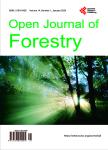Classification System for Monitoring Historic Changes in Forest and Non-Forest Woody Vegetation—A Basis for Management
分类系统监测历史性变革森林和非森林木本植被 - 一种用于管理基础作者机构:Faculty of Environmental SciencesCzech University of Life Sciences PraguePragueCzech Republic
出 版 物:《Open Journal of Forestry》 (林学期刊(英文))
年 卷 期:2014年第4卷第1期
页 面:75-84页
学科分类:1002[医学-临床医学] 100214[医学-肿瘤学] 10[医学]
基 金:supported by Ministry of Agriculture of the Czech Republic project No.CR QH 82106 Re-cultivation as a tool for landscape functionality regeneration after opencast brown coal mining
主 题:Forest Development Forest and Non-Forest Woody Vegetation ArcGIS Sokolov Region
摘 要:Forest and non-forest vegetation fulfils many non-productive and productive functions. A good understanding of the trajectories and drivers of the woody vegetation change is necessary for the relevant management. Recently, the number of studies devoted to monitoring forest cover changes has increased. However, these works do not fully distinguish between different categories of forest and non-forest woody vegetation. The main aim of the study was to propose a classification system for monitoring historic changes of woody vegetation in the landscape. The period of the last 150 years was mapped through three time-lines (1842, 1953 and 2011). Data were obtained by interpreting historic maps (Stable Cadastral map of 1842) and historical (1953) and current orthophoto (2011) using ArcGIS tools. The classification was applied on the example of Sokolov region (57 km2) located in western Bohemia. The result of the research is a proposal for classifying woody vegetation stands into four categories based on the structural and localisation criteria: (1) Line adjacent woodlands, (2) Landscape woodlands, (3) Settlement woodlands, and (4) Compact woodlands. Information on the woody vegetation development using the proposed classification system is important for understanding the patterns, pressures, and driving forces that led to the formation of the present-day forest and non-forest woody vegetation in the landscape. The results can also be applied as a basis for future forest management practice as they can be used in other different fields, e.g. history, archaeology etc.



